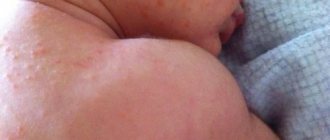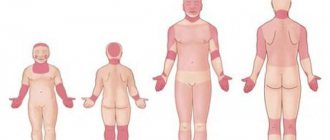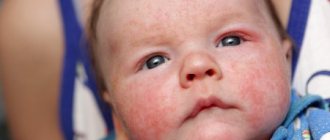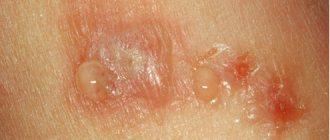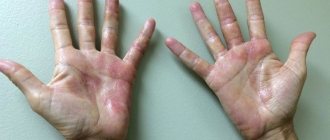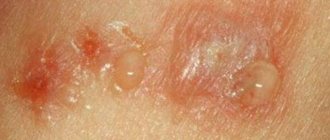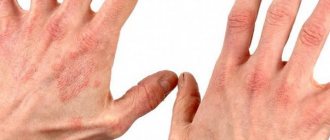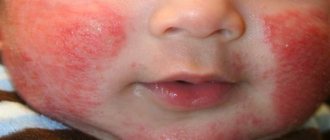Allergic dermatitis is an inflammation of the skin that develops as a result of its direct contact (sometimes short-term) with a facultative irritant, i.e., a substance that does not cause the development of any pathologies in most healthy people. The second name for this disease is contact dermatitis.
The main role in the development of allergic dermatitis in children belongs to genetic factors
Causes and risk factors
Allergic dermatitis refers to delayed-type allergic reactions, in which the main role is played not by antibodies, but by cells of the immune system and, above all, lymphocytes.
The following chemicals may cause symptoms of allergic dermatitis:
- paint and varnish products;
- washing powders;
- cosmetic and perfumery products;
- synthetic fabrics;
- latex.
Some medications (antibiotics, vitamins, syntomycin emulsion), and nickel jewelry can also act as allergens. Very often, the cause of allergic dermatitis on the hands is contact with plants (white ash, primrose, hogweed). This form of the disease is called phytodermatitis.
Allergic dermatitis may be a reaction to household chemicals
A special role in the development of an allergic reaction upon direct contact of the irritant and the skin is played by the phagocyte cells located in it. They absorb and digest allergens and immune complexes that enter the skin. After applying a specific irritant to the skin of a sensitized person, the number of phagocyte cells increases several times in a short period of time.
Phagocyte cells not only digest allergens, but also promote their contact with specific cells of the immune system, which causes a full-blown immune response, i.e., the development of an allergic reaction.
You can reduce the risk of developing allergic dermatitis by limiting contact with household chemicals. When working with them, you should use personal protective equipment (respirator, rubber gloves).
When the skin comes into contact with the allergen again, the allergic reaction occurs more vividly and violently than the first time. This is explained by the fact that the patient’s body already has antibodies and immune cells to this allergen.
Phagocytes and lymphocytes at the site of inflammation also contribute to redness and swelling of the skin, dilation of blood vessels, and increased itching.
Predisposing factors to the development of allergic dermatitis are:
- thinning of the stratum corneum of the skin;
- increased sweating (hyperhidrosis);
- chronic inflammatory diseases accompanied by impaired immune response;
- predisposition to the development of allergic reactions.
Stages
The clinical picture largely depends on the stage of the disease.
initial stage
A pinpoint rash begins to appear in the affected area, very similar to the manifestation of urticaria, as can be seen in the attached photos.
Associated symptoms of solar dermatitis are itching and burning. With severe weakness of the body and an acute form of the disease, general well-being also suffers, inflammation of the conjunctiva of the eyes and cheilitis occur.
At the resolution stage, the upper layer of the epidermis peels off, leaving a pigmented area of skin at the site of exposure.
If you do not stop the influence of the photosensitizing factor, under the influence of the sun or when visiting a solarium, the disease takes a recurrent course, that is, it becomes chronic.
Chronic stage
The duration of the disease from the first sign to complete recovery is about 2-3 weeks. But in the absence of protection and repeated exposure to ultraviolet radiation, rashes occur again. This phenomenon is called chronic photocontact dermatitis. Damage to the epidermis looks very unattractive and causes severe discomfort.
Changes in the skin during the chronic stage are shown in the following photo.
There is an increase in the pattern, infiltration and severe dryness of the epidermis, the appearance of areas of excessive pigmentation, scar tissue and spider veins.
Symptoms of allergic dermatitis
Skin lesions in allergic dermatitis are always localized at the site of contact with the irritating factor. For example, if the allergen is washing powder, then you should expect the development of allergic dermatitis on your hands. At the same time, the symptoms of allergic dermatitis on the face are most often caused by individual intolerance to cosmetics (powder, mascara, foundation, lipstick, blush).
In allergic dermatitis, the lesion always has clearly defined boundaries. Initially, swelling of the skin and its redness are observed. Then papules (dense nodules) appear, which quickly turn into blisters filled with clear liquid. After some time, the bubbles open, and erosion appears in their place. All these skin changes are accompanied by severe itching.
Repeated skin contact with an allergen can lead to the formation of chronic allergic dermatitis. In this case, the lesion acquires blurred boundaries, and the inflammatory process can spread to distant areas of the skin, including those not in contact with the irritant. Symptoms of the chronic form of allergic dermatitis are:
- thickening of the skin;
- dryness;
- peeling;
- formation of papules;
- lichenization (increased severity of skin pattern).
Due to severe itching, patients constantly scratch the lesions, which is accompanied by trauma to the skin and can lead to the addition of secondary purulent-inflammatory lesions.
Allergic dermatitis is characterized by severe itching
Diagnostic measures
In order to build the correct treatment plan, it is necessary to undergo diagnostics. It is carried out in a medical office (a dermatologist or allergist is the doctor you need to contact).
Basic techniques carried out by specialists:
- applications are specific tests involving the application of an allergen to the skin. There can be from 1 to 20 per session. Then you need to wait up to 3 hours to assess the degree of manifestation of the reaction to the stimulus. Vasodilation is visually observed. After 6-8 hours, a rash may appear at the site of contact with allergens. In this case, a specific allergen is identified, which leads to the development of contact dermatitis;
- urine analysis (general, biochemical);
- blood tests (general and biochemical).
Contact dermatitis is detected through testing under medical supervision. It is carried out using sticky paper plates, on which allergens are previously applied in the required dosage. The paper strips are carefully glued to the skin (it must first be thoroughly cleaned). At the final stage, a photo is taken.
The result will be known after 2 days - all this time the plates must be attached to the skin. After eliminating the allergen, the resulting skin changes, if there is no tendency to react to it, go away very quickly.
It is important to consider that safety during tests and samples is ensured by specialists, since a person does not know what intensity the reaction will be.
In case of severe manifestation, the doctor will immediately give an injection, which will stop the effect of the irritant on the body. It should also be taken into account that such a study (even with the application of a single allergen) can be carried out during a period of remission in order to reduce the load on the body and immune system.
Additionally, according to indications, special blood tests for hormones are performed. To eliminate doubts, you may need to undergo an ultrasound of the abdominal cavity and tests for dysbacteriosis. These studies are required to exclude diseases with similar clinical manifestations.
Features of allergic dermatitis in children
Allergic dermatitis is a fairly commonly observed pathology in childhood. The disease has a chronic course, characterized by alternating periods of remissions and exacerbations. After puberty, in most adolescents, the signs of allergic dermatitis completely disappear.
The main role in the development of the disease in children belongs to genetic factors. If one of the parents suffers from allergies, then the probability of the child developing the disease is 50%, if both - 80%. If both father and mother are healthy, then the risk of allergic dermatitis in their offspring does not exceed 20%. However, the disease develops in children only when exposure to a specific irritant, i.e., an allergen, is added to the hereditary factor. Allergy factors may include:
- respiratory factor (inhalation of dust, aerosols, pollen);
- food factor (certain foods that are perceived by the child’s immune system as harmful irritants);
- contact factor (aggressive substance, for example soap, shampoo or baby cream).
Allergic dermatitis in infants initially manifests itself as a variant of food allergy that occurs as a result of non-compliance by a nursing mother with a hypoallergenic diet or the early introduction of complementary foods (eggs, cow's milk, cereals) into the child's diet. In the future, exacerbations of the disease are provoked not only by food allergens, but also by other irritants (house dust, fungal spores, animal epidermis, plant pollen). In many children in the first years of life, the cause of the development of allergic dermatitis is infection with certain types of staphylococcus, which cause chronic inflammation of the skin.
In children, allergic dermatitis initially manifests itself as a variant of food allergy
The main symptoms of allergic dermatitis in children are:
- local or generalized redness of the skin (hyperemia);
- areas of skin irritation and/or peeling;
- itching or burning;
- tearfulness;
- sleep disorders;
- dysfunction of the digestive system.
During allergic dermatitis in children, there are several age stages:
- Infantile dermatitis. It occurs from the first months of a baby’s life and lasts until the age of two. The disease is manifested by the appearance of characteristic rashes on the flexor surface of the child’s arms and legs, in natural skin folds. Often, in children with allergic dermatitis, an abundant small rash appears on the face in the cheek area, causing the cheeks to look painfully crimson. The lesions often become wet and covered with crusts.
- Children's dermatitis. It is observed in children from 2 to 12 years old. It is characterized by the appearance of areas of skin redness, with plaques, cracks, scratches, erosions and crusts. These lesions are in most cases localized in the area of the elbows and neck.
- Teenage dermatitis. Diagnosed in adolescents from 12 to 18 years of age. At this age, in most cases, the manifestations of allergic dermatitis disappear on their own, but in some adolescents, the symptoms of the disease, on the contrary, increase their severity. In these cases, contact with the allergen leads to the appearance of rashes on the face, neck, elbow pits, hands, feet, fingers and natural folds of the skin.
Symptoms
The initial signs of solar dermatitis are quite clearly demonstrated by the following photo.
After minor exposure to the sun or UV rays in a tanning bed, severe redness and local swelling occur on the skin. This violation resembles the initial degree of a burn.
The changes are predominantly localized in the torso area; the face is rarely affected. It is extremely rare to find rashes on the palms and soles.
In an adult, the pathology affects areas of the skin with a small amount of pigment. In children, the disease occurs rarely and can manifest itself not only on the body, but also on the cheeks and face. You can see what photodermatitis looks like in a small child in the following photo.
Diagnostics
The diagnosis is made by identifying a combination of three major and at least three minor criteria in the patient. Major diagnostic criteria for allergic dermatitis include:
- recurrent nature of the disease;
- family or personal history of allergies;
- typical localization of rashes (under the earlobes, scalp, groin area, popliteal and elbow fossae, armpits, neck and face);
- severe itching of the skin, even with a small amount of elements of the rash.
Allergic dermatitis refers to delayed-type allergic reactions, in which the main role is played not by antibodies, but by cells of the immune system and, above all, lymphocytes.
Additional or minor diagnostic criteria include:
- onset of the disease in the first years of life;
- increased level of IgE antibodies;
- follicular hyperkeratosis, affecting the skin of the elbows, forearms and lateral surfaces of the shoulders);
- whitish spots on the skin of the shoulder girdle and face (Pityriasis alba);
- folding of the soles and palms (hyperlinearity);
- folding of the anterior surface of the neck;
- white dermographism;
- frequent infectious skin lesions of herpetic, fungal or staphylococcal etiology;
- nonspecific dermatitis of the legs and arms;
- ichthyosis, xerosis, peeling;
- redness and itching of the skin after taking a bath (this sign is detected in children in the first two years of life);
- symptom of “allergic glow” (dark circles around the eyes);
- increased sweating (hyperhidrosis), accompanied by itching.
Allergy skin tests help determine the cause of allergic dermatitis
To identify the allergen that caused the development of the disease, special skin tests are performed. To perform them, test strips impregnated with various allergens are used. These strips are fixed to an area of well-cleaned skin. After a certain time, they are removed and the presence or absence of an allergic reaction is assessed by swelling and redness of the skin.
Additional diagnostic tests may be required to identify concomitant pathologies:
- general blood analysis;
- blood biochemistry;
- blood sugar;
- general urine analysis;
- general stool analysis;
- microbiological examination of stool.
If necessary, the patient is consulted by a gastroenterologist or endocrinologist.
The wealth of symptoms of the disease
Photos of what contact dermatitis looks like can show a very diverse clinical picture, depending on how strong the irritant was on the skin. So, in the case of a powerful allergen, the skin not only turns red, but swells and becomes covered with weeping blisters. The affected areas become baked and ulcerations appear.
Treatment of allergic dermatitis
Under the influence of allergens, many complex biochemical processes are launched in the patient’s body, so treatment of allergic dermatitis should be long-term and comprehensive, including the following areas:
- identifying and eliminating contact with the allergen;
- diet therapy;
- systemic pharmacotherapy (membrane-stabilizing and antihistamines, corticosteroids, antibiotics, immunomodulators, vitamins, drugs that regulate the functions of the gastrointestinal tract and central nervous system);
- external therapy (talkers, ointments, lotions);
- rehabilitation.
The main goals of the treatment of allergic dermatitis are:
- restoration of the functions and structure of the skin (normalization of humidity, improvement of metabolism and reduction of the permeability of the walls of blood vessels in the lesion);
- elimination of skin itching and manifestations of the inflammatory reaction;
- prevention of progression of the disease to a severe form, which can cause patients to lose their ability to work;
- therapy of concomitant pathology.
Considering that the pathological mechanism of development of allergic dermatitis is based on allergic inflammation, basic therapy is carried out with antihistamines and anti-inflammatory drugs.
In the chronic course of the disease, it is important to observe the stages and duration of treatment.
The general treatment regimen for allergic dermatitis in the acute phase includes the administration of the following medicinal groups of drugs:
- antihistamines with additional membrane-stabilizing and anti-mediator effects (second generation) for 4-6 weeks;
- first generation antihistamines (with sedative effect) at night;
- lotions with a 1% tannin solution or a decoction of oak bark in the presence of exudation;
- creams and ointments with corticosteroids (prescribed in a short course lasting no more than 7-10 days);
- systemic corticosteroid therapy (only if there is no effect from the therapy described above).
In the treatment of allergic dermatitis, ointments and creams with corticosteroids are prescribed
Treatment for chronic allergic dermatitis includes:
- second generation antihistamines for a long course (3-4 months);
- polyunsaturated fatty acids;
- immunosuppressive drugs (drugs that suppress excessive activity of the immune system);
- externally ointments with corticosteroids and antibiotics.
After achieving remission, it is necessary to carry out treatment of allergic dermatitis, aimed at preventing exacerbations of the disease. In this case, the following scheme is usually used:
- third generation antihistamines (active metabolites) for a course of 6 months or more;
- immunomodulators;
- specific immunotherapy with allergens;
- preparations containing polyunsaturated fatty acids.
Experimental treatment for allergic dermatitis
Clinical trials of the drug nemolizumab in the treatment of allergic dermatitis are currently underway. It is a member of a group of humanized monoclonal antibodies specific for interleukin-31.
The results of the second phase were published in 2020 in The New England Journal of Medicine. The drug was prescribed for three months to 264 adult patients suffering from severe forms of allergic dermatitis, in whom traditional treatment did not lead to a lasting positive effect. The patients were divided into two groups, one of them received nemolizumab, the other (control) received placebo. The effectiveness of therapy was assessed based on measuring the area of the affected area and the severity of the intensity of itching (assessed using a special visual analogue scale).
During treatment with nemolizumab, the intensity of itching decreased in 60% of patients, in the control group in 21%. A reduction in the area of lesions in the main group was recorded in 42% of patients, and in the control group in 27%. These results gave grounds to consider nemolizumab a promising drug in the treatment of allergic dermatitis.
Treatment of contact dermatitis
If simple contact dermatitis develops, the first step is to identify and eliminate the irritant and, if necessary, use gloves and protective clothing. Before starting therapy, the skin must be thoroughly cleansed and washed.
Patients with allergic contact dermatitis often do not require treatment, since all painful manifestations disappear after eliminating the allergen. However, if necessary, potent hormonal fluoride creams and ointments can be prescribed
In cases where skin rashes are localized on the face or genitals, internal administration of glucocorticoids may be recommended for 2-3 weeks.
In order to improve the penetration of drugs, the application of occlusive (hermetic) dressings that block air access is indicated. During this period, the use of ointments with anesthetics is not recommended, as they are sensitizers and can increase irritation. However, local antihistamines can worsen the course of the disease.
When a secondary infection occurs, patients are given systemic antibacterial therapy, and hormonal ointments are simultaneously prescribed. For severe allergic contact dermatitis, salt or water lotions are applied to the affected areas. For severe itching, use ice or cold water.
In the acute stage of severe contact allergic dermatitis, systemic glucocorticosteroids are used.
Nutrition for allergic dermatitis
Diet therapy plays an important role in the complex treatment of allergic dermatitis. It allows you to reduce treatment time and helps achieve stable remission. Products that increase sensitization of the body are excluded from the diet. These include:
- coffee;
- cocoa;
- chocolate;
- nuts;
- citrus;
- pickles and marinades;
- legumes;
- strawberry;
- seafood.
You should not eat foods that contain dyes, emulsifiers, or preservatives, as all these substances are strong allergens.
If you have allergic dermatitis, you need to exclude all allergenic foods from your diet.
Also, fried foods and rich, strong broths are not recommended for patients suffering from allergic dermatitis. This is explained by the fact that they enhance the absorption of irritating substances by the mucous membrane of the gastrointestinal tract.
Very often, the cause of allergic dermatitis on the hands is contact with plants (white ash, primrose, hogweed). This form of the disease is called phytodermatitis.
It is recommended to reduce the consumption of salt and sugar by 2-3 times, and even better, if possible, completely abandon their use during therapy. Before use, cereals must be washed in several waters and soaked for several hours.
For allergic dermatitis, nutritionists recommend eating:
- stewed or steamed lean meat;
- black bread;
- natural fermented milk products (without preservatives, sweeteners and dyes);
- freshly squeezed apple juice;
- greens (dill, parsley);
- cereals (rice, oatmeal, buckwheat);
- olive oil (no more than 25-30 grams per day).
Traditional treatment of allergic dermatitis
In consultation with the attending physician, some traditional medicine methods can be used in the complex therapy of allergic dermatitis, for example:
- lotions with decoctions of medicinal herbs (chamomile, viburnum or oak bark, black currant bark, string);
- compresses with decoctions of felt burdock, calendula, lemon balm, elecampane roots;
- lubricating the affected areas with an ointment made from a mixture of baby cream or melted goose fat and sea buckthorn oil;
- aromatherapy with sandalwood, geranium or lavender oil;
- medicinal baths with decoctions of wild rosemary leaves, medicinal valerian roots, blue cornflower or chamomile flowers, nettle leaves and common oregano.
Folk remedies can be used as part of complex treatment of allergic dermatitis
Forecast
If it is possible to identify and eliminate contact with the allergen, then the prognosis for allergic dermatitis is favorable, the disease ends in complete recovery.
In cases where it is not possible to eliminate contact with the allergen, allergic dermatitis becomes chronic and periodically worsens. The sensitization of the patient's body gradually increases, which ultimately becomes the reason for the generalization of the process and the development of systemic allergic reactions, even life-threatening ones.
Treatment
When a specialist has confirmed the diagnosis of “allergic dermatitis”, treatment can begin.
First of all , it is necessary to relieve skin itching and irritation : Bepanten and Physiogel ai cream for allergic dermatitis will help cope with unpleasant sensations, soften damaged areas and speed up the healing of ulcers, cracks and scratches.
To relieve severe inflammation, you may need ointments based on corticosteroids: Advantan, Elidel and their analogues. Long-term use of such drugs is dangerous , so it is not recommended to use them for more than 5 days in a row. They have a large list of contraindications and side effects, so if possible, it is better to do without hormonal drugs.
Of course, like any other type of allergy, dermal allergies require the use of antihistamines . New generation drugs, such as Erius, Zyrtec, are devoid of unpleasant side effects such as drowsiness and problems with concentration, which were often caused by medications that were common in the recent past.
However, they should not be taken without a specialist's prescription. Only a doctor can select the most suitable drug for each specific case .
for a patient who has been diagnosed with allergic dermatitis to rid himself of contact with the allergen : change cosmetics, start using a softer washing powder, choose new clothes made from natural materials. If microscopic dust mites act as an irritant, you should give preference to pillows and blankets stuffed with synthetic down and wash them regularly, and also, if possible, remove dust-collecting furniture and interior items from your home.
Allergic reactions caused by food require diet. It is necessary to find out which food causes the skin rash and eliminate it from the diet.
The list of foods that most often provoke dermatitis includes:
- Citrus fruits such as oranges, tangerines, grapefruits;
- Nuts – hazelnuts, walnuts, cashews, peanuts;
- Coffee;
- Chocolate, especially bitter;
- Strawberry;
- Eggs (and often a person with intolerance to chicken eggs can easily eat duck and quail eggs);
- Sea fish and seafood;
- Red meat;
- Legumes – beans, peas, lentils, fava beans.
List of allergen products - photo
It is also recommended to avoid fried, smoked, salty foods , foods that contain large amounts of food coloring, flavorings, flavorings and preservatives. Before cooking, it is advisable to soak cereals for 10-12 hours, pour boiling water over fresh vegetables and fruits, and thoroughly boil meat.
Allergic dermatitis, which is caused by nickel, also requires dieting. Many products from the list above are rich in this metal, as well as seeds, buckwheat, oatmeal, tomatoes, and millet.
With Lyell's syndrome, patients are hospitalized in a burn department and given large doses of methylprednisolone and antihistamines. Symptomatic treatment is also necessary in the form of intravenous infusions of saline to prevent dehydration, irrigation of ulcerated skin and mucous membranes with astringents and disinfectants. The addition of a secondary bacterial infection requires antibiotic therapy.
Prevention
There is no primary prevention aimed at preventing the disease of allergic dermatitis. The risk of its development can be reduced by limiting contact with household chemicals. When working with them, you should use personal protective equipment (respirator, rubber gloves).
When purchasing clothes and jewelry, you should give preference to quality products from reliable manufacturers. This will reduce the likelihood of skin contact with toxic metals and dyes, which often become allergens.
If the disease has already occurred, it is necessary to carry out active treatment aimed at achieving a state of remission. To do this, first of all, the allergen should be identified and further contact of the patient with it should be excluded.
Video from YouTube on the topic of the article:
